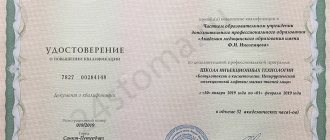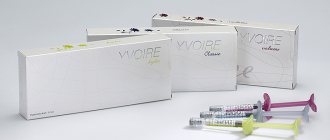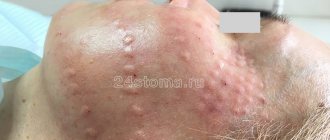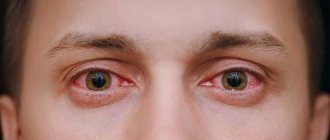How to get rid of wrinkles: rejuvenation with hyaluronic acid injections
Modern cosmetological rejuvenation techniques differ from those that women and men were forced to resort to 20 or 30 years ago - they are safe, effective, carried out on an outpatient basis and have very few contraindications and risks. Basically, those who are interested in how to remove wrinkles choose one of the injection methods - and among them, hyaluronic acid injections or biorevitalization are very popular. A safe procedure with a quick recovery period can significantly rejuvenate the face and improve the condition of the skin - biorevitalization with hyaluronic acid not only helps reduce small and medium wrinkles, but also gets rid of dark circles under the eyes, refreshes the skin color, improves its condition, and increases elasticity.
What is facial biorevitalization, who does it help, and what features does this procedure have?
Advantages and disadvantages of both methods
| A drug | Advantages | Flaws |
| Botox | Rapidly growing effect, high-quality smoothing of wrinkles. No hematomas or swelling | Inability to affect non-mimic wrinkles. Fragility of results. |
| Hyaluronic acid | Hypoallergenic. High biological compatibility with tissues. Disintegrates over time and is excreted from the body. Not addictive. | Short duration of results. Minor pain during the procedure. |
What is biorevitalization
Biorevitalization is an injection cosmetic procedure that involves the subcutaneous injection of hyaluronic acid into tissues. Hyaluronic acid is a natural substance found in our skin that retains moisture. With age, the amount of hyaluronic acid in tissues decreases, moisture in cells becomes less, and the skin begins to age - it loses its firmness, elasticity, its color and texture deteriorate, the skin looks tired and withered. Injections of hyaluronic acid replenish its reserves in the skin, in addition, they stimulate the formation of elastin and collagen in the tissues - “youth proteins”, which are responsible for the elasticity of the skin.
As a result of the biorevitalization procedure, intensive restoration processes begin in the skin tissues - and already 7-10 days after the first procedure you can see the result, and after a course of 3 to 7 procedures, the difference will be huge. If you look at the photo before and after biorevitalization, you will notice how the oval of the face has tightened, the dark circles under the eyes have decreased, small wrinkles have disappeared, the color of the skin has changed, and the relief has become smoother.
WHY DO WRINKLES APPEAR?
One of the reasons for the appearance of wrinkles after 30 years is a decrease in the synthesis of hyaluronic acid. This component of the extracellular matrix fills the space between collagen and elastin fibers, which are responsible for the elasticity and youth of the skin. When the synthesis of hyaluronic acid slows down, deep wrinkles appear in the areas where facial expressions are most active.
Fillers (from the English “fill”) are a cosmetic injectable gel that helps fill wrinkles and smooth the skin.
Biorevitalization procedure
Before the biorevitalization procedure at the clinic on Komarova, you will be seen by a cosmetologist who will assess the condition of your skin, select the optimal hyaluronic acid preparation for you, and also draw up an injection regimen and determine the duration of the course. As a rule, the course consists of 3-7 procedures, which are carried out once every 3-4 weeks. It is recommended to repeat the biorevitalization course every 8-12 months to consolidate the results and prolong the youth and beauty of the skin.
During the consultation, the cosmetologist talks in detail about the procedure, warns about possible contraindications, and also explains how to properly care for the skin after biorevitalization.
The procedure is performed on an outpatient basis and takes no more than 30 minutes. First, an anesthetic ointment is applied to the skin. After about 15 minutes, the face becomes numb - and you can start injections.
The biorevitalization procedure is carried out under sterile conditions, the patient’s face is treated with an aseptic solution, the hair is tucked under a cap, and the doctor wears gloves. He opens the ampoule with hyaluronic acid in the presence of the patient, letting him read the name and expiration date of the drug. Then, using a syringe with a very thin needle, he makes several dozen subcutaneous injections - the patient practically does not feel them due to the anesthetic. After this, the face is treated with an antiseptic and anti-inflammatory cream, and the patient can go home.
It is not advisable to start work after the procedure - marks from injections (papules) are clearly visible on the face in the first few hours. The next day or the day after, the papules are no longer noticeable.
The most common hyaluronic acid preparations are products from the brands Restylane, Juvederm, Ial-System, etc. These are modern, high-quality, safe preparations that differ from each other in the concentration of hyaluronic acid and, accordingly, are intended for different skin types. Some of them contain anesthetics and antioxidants, vitamins, nucleic acids, and peptides.
HOW DO 3D HYALURONIC FILLERS WORK?
The key active ingredient of Libriderm 3D hyaluronic fillers is high-quality hyaluronic acid of different molecular weights, produced in Switzerland.
- High molecular weight (100+ kDa) remains on the surface of the stratum corneum of the skin and increases its hydration.
- Medium molecular weight (30-100 kDa) accelerates skin regeneration by stimulating the division of epidermal cells.
- Low molecular weight (<30 kDa) penetrates from the surface of the skin into the deep layers of the dermis and helps fill wrinkles.
The composition of 3D hyaluronic fillers is supplemented with extract of crushed leaves of Stevia honey, which has local anticholinergic activity - relaxes facial muscles*, preventing the formation of new wrinkles.
Indications and contraindications for biorevitalization
Indications for biorevitalization are deterioration of the skin condition due to age-related changes, bad habits, negative environmental influences, stress, lack of sleep, etc. Biorevitalization does not help eliminate deep wrinkles, but it copes well with minor problems. Also, the biorevitalization procedure is usually recommended as a preparation for the introduction of fillers, installation of mesothreads or Aptos threads, or after a vacation at sea as a restorative agent and prevention of skin photoaging.
Contraindications to biorevitalization:
- pregnancy and breastfeeding;
- bleeding disorders or taking anticoagulants (you must stop taking such drugs a week before the procedure and do not take them for a week after it);
- systemic blood diseases, acute infectious or general diseases, exacerbation of chronic diseases, febrile conditions, high temperature;
- skin diseases in the injection area;
- mental illness;
- tendency to form keloid scars;
- other contraindications (determined after consultation with a doctor).
Jewelry work
Like other injection procedures, contouring should be performed only in a clinical setting and only by a professional doctor who has a diploma and certificates allowing him to practice medicine. Strict hygienic requirements will help avoid infection of puncture sites, and the highly qualified cosmetologist will help you choose the right drug and inject it safely.
When contouring first became available, it was used to treat specific problems, such as filling wrinkles or enhancing lips. Nowadays, cosmetologists examine the entire face, as a whole. This approach provides the most natural and attractive result, allows you to harmonize the face, rather than working separately with a specific area, and does not deprive a person of his individuality. For example, to eliminate a nasolabial fold, you can work a little on the cheekbones and cheek area. By introducing filler into these areas, the tissues are lifted and the desired result is achieved: support is created for the tissues, their sagging is prevented, and the volumes in the most deficient area are replenished. This solves the problem of not only the nasolabial fold, but also the lack of volume in the middle third of the face.
Such work is akin to the work not even of a sculptor, but of a jeweler.
A cosmetologist must have a very good understanding of anatomy and physiology in order to achieve the optimal effect.
Under no circumstances should you trust such a procedure to an unqualified specialist: the risk of complications, filler migration, overcorrection, ischemia, tissue necrosis, and even blindness is too great. A cosmetologist must have a diploma, certificates of a dermatovenerologist and a cosmetologist. All these certificates are confirmed by a doctor every five years. If at least one document from the list is missing, it’s better not to risk it and look for another specialist! Your health is only in your hands! You need to trust professionals!
Biorevitalization results: before and after
After the first procedure, the result of biorevitalization can only be noticeable in the “before” and “after” photos - the difference, as a rule, is not yet visible to the naked eye. However, after 2-3 procedures, the condition of the skin noticeably improves - wrinkles and folds become less pronounced, the color and texture of the face becomes better, and the oval is tightened.
Immediately after the procedure, papules may persist for 1-3 days (less often – up to 5 days, depending on the individual sensitivity of the skin). In the most delicate places - for example, in the area under the eyes, sometimes on the chin or cheekbones - small bruises and bruises remain after injections. During the first day, it is not recommended to use any absorbable ointments, but from the second day you can use them. Also, during the first two days, slight swelling may persist on the face - a skin reaction to the injections.
CAN IT BE COMBINED WITH PRODUCTS IN OTHER LIBREDERM COLLECTIONS?
Can. Focus on your skin type and the effect you want to achieve. For example, for deep wrinkles and a pronounced loss of skin elasticity, combine products from the hyaluronic fillers collection with Mezolux bio-reinforcing creams.
- Clinical study in vivo, n=20 from 45 to 65 years, measured after 7 days of use.
- Clinical testing, n=10, from 30 to 50 years, measured at 0, 30, 120 and 240 min. Visioscan instrumental measurement.
- * Clinical study in vivo, n=20 from 45 to 65 years, measured after 7 days of use.
- **In vitro study measuring the increase in acetylcholinesterase enzyme action by Stevia honey leaf extract.
- *** In vivo test under the supervision of dermatologists, 25 respondents, testing the active ingredient in its pure form.
How to care for your skin after hyaluronic acid injections
On the day of the procedure, do not touch your face with your hands, do not use cosmetics, and wash your face with mild products without soap. To remove swelling and reduce possible discomfort, you can apply ice. The skin can be treated with a chlorhexidine solution and anti-inflammatory cream.
You should not drink alcohol for 3 days before or after the procedure.
From the second day, you can use your usual skincare products - face creams, cleansers (without soap), milk, and also use absorbable ointments.
After the biorevitalization procedure, sports, visiting saunas and baths, hot baths, as well as facial massage, cleansing, peeling, facial steam saunas and visiting the solarium are prohibited for 2 weeks.
Fillers
Gels intended for local increase in volume are divided into three types:
- Synthetic;
- Biosynthetic;
- Biodegradable.
The history of contour plastic surgery began with synthetic fillers based on paraffin and silicone. They have one advantage over other types - the result lasts forever. There are a lot of disadvantages: allergic reactions, rejection, and migration of fillers to the most unexpected places. Now the vast majority of doctors have abandoned the use of such drugs due to the unpredictable results and a huge number of complications.
Biosynthetic gel fillers include synthetic components, but such products are based on substances of natural origin. Such drugs provide a more natural result, but often cause allergic reactions and are rejected by the body.
Biodegradable fillers are the most popular type of filler gels based on hyaluronic acid today. To create them, biocompatible substances are used, which over time are independently absorbed and excreted by the body (degraded, resorbed). Such drugs are completely safe and well tolerated, but the effect after their use rarely lasts longer than 24 months (about HA-based fillers).
Fillers based on hyaluronic acid are very common, widely used by cosmetologists, and are well tolerated by patients.
Only fillers based on hyaluronic acid have an antidote! This means that if you don’t like the result or seem excessive, or serious complications arise after the administration of the drug, then it is possible to eliminate these phenomena with the enzyme hyaluronidase, which breaks down hyaluronic acid, turning the filler gel into water.
Silicone gels, biopolymers, containing calcium hydroxyapatite do not have an antidote!!! This enzyme will dissolve them and will not remove them from the body.
Modeling gels based on calcium hydroxyapatite, an inert mineral that is part of bone tissue, stimulate collagen production. Fillers with polylactic acid also contain an analogue of a substance of natural origin and stimulate skin renewal, firmness, turgor and affect its quality.
Today, most clinics use biodegradable varieties - they are safe and provide a completely natural effect. Preparations for volumetric modeling differ in density, viscosity, and durability. The choice of a specific filler depends on the area of application, age and individual characteristics of the patient. For example, for lip augmentation, more fluid, delicate gels are used, and for correction of the chin or cheekbones, denser and less plastic ones are used.
The safety of biodegradable drugs does not mean that you can trust anyone to carry out the procedure, as long as the filler is of high quality. The success of the procedure only partially depends on the drug; what is more important is the professionalism of the doctor, the accurate calculation of the dose and injection site, and the correct execution of the injection.
How long does it take to recover after filler injection?
Usually after the procedure there is noticeable swelling, a feeling of distress, and sometimes also slight pain at the injection site. In fact, the treatment does not require a recovery period and you can return to your professional activities the same day.
It is not recommended to go on flights, take a bath or play sports, as this can displace the hyaluronic acid.
The skin turns slightly red after treatment. If the patient wants to apply makeup, this can be done exclusively using disposable cosmetic instruments. It is important not to do this with repeatedly used brushes and sponges.
How long does the wrinkle filling procedure take?
Exactly how long the procedure will take depends entirely on what we are going to do and in what area. The filling of wrinkles itself is relatively quick, since it comes down to the injection of the drug. What takes the most time is a thorough analysis of the patient's face and the appropriate planning of the procedure, which can be more or less labor-intensive. Much depends, of course, on the doctor’s experience.
Typically, together with a consultation, interview, drawing up a plan of action and explaining to the patient what he can expect, the procedure takes from 30 minutes to an hour.
What are the contraindications for treating wrinkles?
Absolute contraindications to the wrinkle filling procedure include inflammation at the site of application of the drug or a general infection of the body. We will not perform the procedure while the patient is pregnant or breastfeeding.
Most medications contain lidocaine, to which some patients are allergic. Therefore, in case of allergic reactions to the drug, the procedure is not performed.
It is believed that wrinkle treatment is not available for people with Hashimoto's disease. This is not an absolute contraindication. Such a patient receives a referral for an antibody level test. After assessing the results, injections can be given, but the patient should be aware that there is a higher risk of certain side effects after the procedure or in the future. This is a special situation and requires a special approach.










